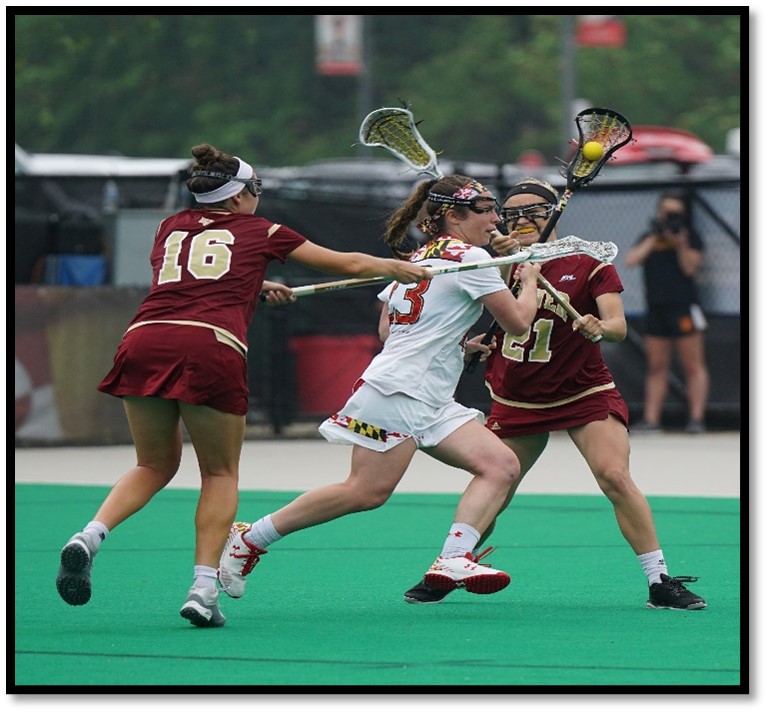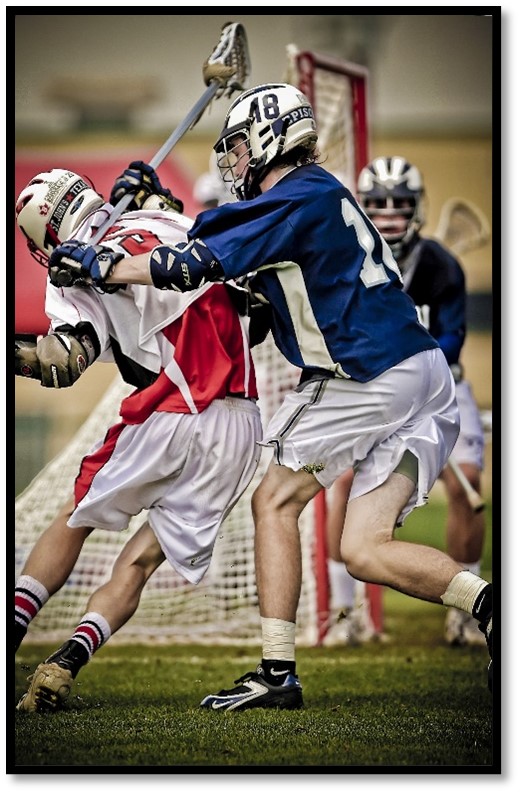02/22/2022
Identifying, Preventing, and Treating Lacrosse Injuries
By Dr. Mark Cullen, Wentworth Health Partners Seacoast Orthopedics & Sports Medicine
Lacrosse is America’s oldest and currently fastest-growing team sport. Lacrosse is a very popular sport in New Hampshire, and many New Hampshire lacrosse players are playing lacrosse in college. It is played by both girls and boys of all ages. It is a fast-paced team sport with end-to-end action that compares to basketball and hockey. Lacrosse’s combination of speed, agility, hand-eye coordination, stick/ball use, and contact lead to several different injuries.

Girls and Boys lacrosse are different
Though sharing general concepts, girls’ and boys’ lacrosse play by very different rules and use different protective equipment. Girls’ lacrosse uses a stick with a very shallow pocket. Body contact is limited and stick checking must be controlled and must be away from the head and body. Protective goggles and a mouthpiece are optional, but there is no other protective equipment. Boys’ lacrosse uses a stick with a deep pocket and is a high contact sport. Helmets with full facemasks, shoulder pads, gloves, and mouthpieces are required.
What are common lacrosse injuries?
Lacrosse has a wide range of injuries. Injuries differ by age. High-quality coaching and officiating help to control contact to limit injuries. Most lacrosse injuries are minor strains, sprains, and contusions, but more significant injuries occur. I have been involved with lacrosse for 14 years with three of my children. Most of their injuries have been relatively minor. Some of their injuries have included: clavicle fracture, hand fractures, foot fracture, major foot injury, shin splints, ankle sprains, lumbar strain, arm contusions, thigh contusion, foot contusion, bruised ribs, hamstring strain, sunburn, and heat illness. Lacrosse is a moderate-risk sport, but more significant injuries do occur.
- Knee injuries, including anterior cruciate ligament (ACL) tears, are the leading cause of lost game and practice time for both girls and boys. These occur both with and without contact. Unfortunately, like soccer and basketball, ACL tears are more common in girls, lacrosse.
- Ankle sprains commonly occur while cutting and dodging. Ankle sprains represent 21% of all reported injuries for girls and 16% for boys’ high school lacrosse.
- Muscle strains of the hamstrings, quadriceps, and groin commonly occur in both girls' and boys’ lacrosse. They are related to noncontact mechanisms and can be prevented with proper conditioning, fitness, nutrition, and hydration.
- Concussions are not frequent but unfortunately do occur in lacrosse. In boys’ lacrosse, concussions are typically due to body-to-body contact and head-to-ground contact after a fall. In girls’ lacrosse, concussions are most caused by stick checks and accidental ball contact to the head. These injuries most commonly occur in games rather than practice.
- Facial and dental injuries are more of a concern in girls' lacrosse due to the lack of a helmet. It is important to always wear your mouthpiece and goggles to minimize injuries.
- Shin splints are common and related to continuous running and changing field surfaces. Proper shoe wear and conditioning can help minimize these symptoms.
- Contusions of the arm and thigh are common due to stick checks and the physical nature of both the boys' and girls’ games.
- Sunburn and heat exposure are common problems with summer travel lacrosse. Getting out of the sun and hydrating between multiple games during summer tournaments is essential.
How are lacrosse injuries treated?
Athletic Trainers are present on the sidelines of high school lacrosse games and travel lacrosse tournaments. A health professional should evaluate athletes after an injury before resuming play. Most minor injuries usually respond to rest and ice. More significant injuries require treatment with a physician, physical therapist, and athletic trainer to guide a progression back to lacrosse. It is crucial to be appropriately evaluated and treated for suspected concussions. Players should only return to play when cleared by a physician trained in concussion management.

How can lacrosse injuries be prevented?
- Know the rules/Respect the game - Although boys’ lacrosse allows significant contact, it is still a game that prioritizes finesse and skill. Illegal contact and unprotected hits happen too often and have no place in the game. Coaches and officials must teach the rules and enforce penalties for illegal contact. Girls’ lacrosse allows limited contact and plays by different rules than boys' lacrosse. It is a fast-paced game with limited contact. This is what makes the game exciting and fun to play. Parents, coaches, officials, and players must learn and respect the rules of both games, understanding there are inherent differences between the two.
- Report all injuries - Athletic trainers play an important role in evaluating injuries at games and tournaments. Increased use of athletic trainers at the youth lacrosse level is encouraged. Please discuss all injuries with team coaches when athletic trainers are not present. It is essential to decrease training time and intensity if pain or discomfort persists.
- Fitness / Nutrition /Conditioning – It is essential to stay in shape year-round and to eat a good healthy diet to prevent injuries. Before the lacrosse season, start a graduated plyometrics program, neuromuscular training, conditioning, and strength training geared to lacrosse demands. Perform a dynamic warm-up and gradually increase the intensity of your workouts. Weight training is encouraged to prevent injuries in high school and collegiate lacrosse players.
- Wear protective equipment - Protective equipment needs to be worn. Protective equipment is not optional and can prevent serious injuries. It is imperative for boys’ lacrosse players to wear helmets when shooting in practice and the backyard. Ricochet of a ball off the pipe to the head can cause severe head trauma.
- Hydrate and rest - Lacrosse is a high-paced game that prioritizes speed, fitness, and skill. It is essential to hydrate and get proper rest to prevent overuse injuries. This is particularly important during the summer tournament season, when multiple games are played on a weekend.
- Heat and Sun exposure - Heat and excessive sun exposure are conditions experienced during summer lacrosse. Hydrate and plan to get off your feet and out of the heat between games. Proper sunscreen use helps to limit skin damage and skin cancer risk
- Emergency action plan - All lacrosse organizations should have a well-established emergency medical plan and injury prevention/education programs for their teams and tournaments.
- Take a break - Burnout is common in youth sports. To stay fresh and prevent overuse injuries, all lacrosse players should have at least one or two days a week and one or two months a year away from lacrosse. All lacrosse players are encouraged to play multiple sports. Multiple sport athletes tend to find more success in sports and have fewer injuries than single-sport athletes. Lacrosse has good crossover with basketball and soccer.
Wentworth Douglass Hospital and Mass General Brigham support the Stop Sports Injury Campaign. STOP (Sports Trauma and Overuse Prevention) targets the sports that have the highest rates of overuse and trauma injuries. The development of STOP was initiated by the American Orthopaedic Society for Sports Medicine (AOSSM). For more information explore the link below:
https://www.stopsportsinjuries.org/STOP/Prevent/STOP/Prevent_Injuries/preventinjuries.aspx?hkey=605a1398-5a54-49ab-924e-7f55965d8409

Mark Cullen, MD is a board-certified orthopaedic surgeon and has completed advanced fellowship training in sports medicine and arthroscopic surgery. He has a passion for adolescent sports medicine. Before moving to New Hampshire in 2019, he was the team physician for numerous high schools and club sports teams throughout his career in Atlanta and Oregon. On the Seacoast, he works closely with high school athletic trainers, physical therapists, and coaches to care for athletes and prevent adolescent sports injuries. Having had four shoulder surgeries himself, he understands what an injury means to his patients and the time and dedication it takes to recover from surgery.
Your opinion matters! We value your input and hope you’ll take a moment to review our newsletter and share your thoughts on future content. Please consider filling out this brief survey.